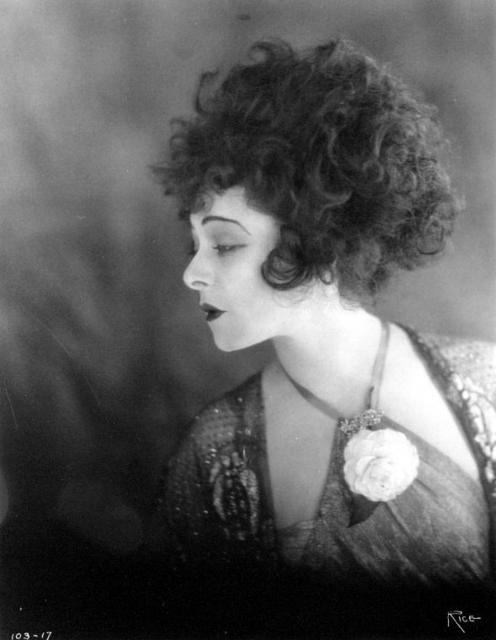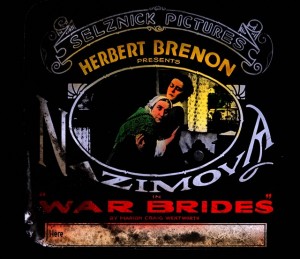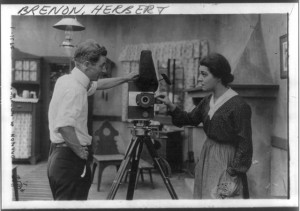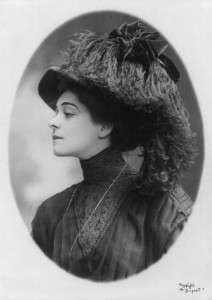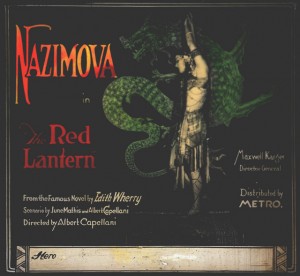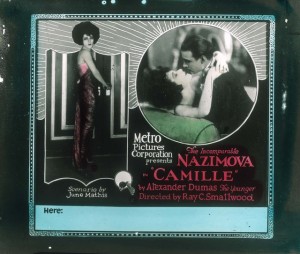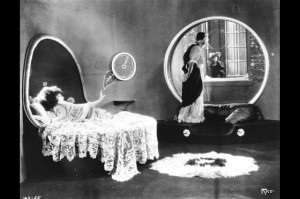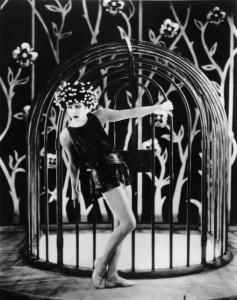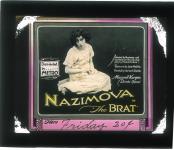Alla Nazimova’s silent film career began in 1916 with her performance as the feisty, indomitable lead character in the screen adaptation of Marion Craig Wentworth’s pacifist drama “War Brides.” Nazimova had performed the role as a one-act play on the vaudeville circuit in an effort to reverse course on the succession of exoticized femme fatale roles that she had accepted under contract first to New York’s Shubert brothers and then to Charles Frohman’s Theatrical Syndicate. The tour production of “War Brides” for the variety stage had been popular and well received, particularly by women’s organizations, presumably just the encouragement independent producer Lewis J. Selznick needed to make his highly profitable film version under the direction of Herbert Brenon. Prior to this performance, Nazimova had a reputation as a moody Bohemian and political subversive. (Emma Goldman once served as her press agent and companion.) With her role in War Brides, a strident feminist was invented, if only temporarily, for the screen. Nazimova boasted to a reporter for the New York American that her decision to appear as figure of suffrage in War Brides was intended to be a contribution to “the womanhood of the world” (Lambert 172). Though periodic image reinvention now seems de rigueur for Hollywood stars, it wasn’t always; part of Nazimova’s legacy is that she is said to have been among the earliest to exercise control over her own celebrity image (Mann 62). With very few exceptions, the path of Nazimova’s motion picture career is described according to skillful and timely reinventions of her public persona and a feminine will as sharply defined as the emotive theatrical poses for which she became known. Stories repeatedly appeared in the press about the actress being “caught” taking in one of her films along with the moviegoing public, suggesting that Nazimova maintained a belief in the primacy of a live appearance, even if she embraced the new medium as an advance over theatre (“Nazimova Sees Herself” 9).
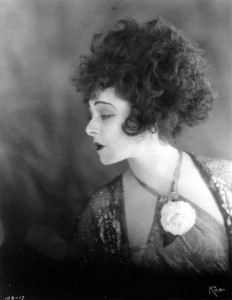
Alla Nazimova, Camille (1921). Courtesy of the Academy of Motion Picture Arts and Sciences, Margaret Herrick Library.
Biographies of Nazimova—including Nazimova’s own unfinished and unpublished memoir, now housed in the Springer Opera House’s Glesca Marshall Library in Columbus, Georgia—have a tendency to trace her lesbian self-styling and her public disavowal back to a traumatic childhood and the archetypal immigrant’s instinct for survival through assimilation. The first act in that life of reinvention could be said to have begun when, at least according to Robert Shanke, at the age of ten, Miriam Edez Adelaida Leventon changed her name to one she admired from a Russian novel (Schanke 129). As biographers tell it, the story of her career always begins with her status as a Russian Jewish émigré overcoming the difficulties of a non-native speaker performing in the theatrical stage classics “Hedda Gabler” and “A Doll’s House.” Famously androgynous and infamously romantically linked to Mercedes de Acosta, Eva Le Gallienne, Natacha Rambova, and Dorothy Arzner, Nazimova became, according to two recent critical career appreciations, “the founding mother of Sapphic Hollywood” (McLellan xxiii), and, for a time, “the most notorious Hollywood lesbian actress of all” (White 1999, 187). The deceptive act of her “fake” marriage to Charles Bryant, the actor who starred opposite her in “War Brides” on stage, becomes, in these scholarly and popular accounts, the ultimate measure of her truly tortured lesbian identity both in Hollywood and among her extended family.
Nazimova juggled a motion picture career that allowed her to continue to perform in both the live theatre and in motion pictures. Working under contract with Metro Pictures Corporation between late 1917 and April 1921, her company, Nazimova Productions, produced nine largely profitable, feature-length films and brought along the writing talent of writer-producer June Mathis. Details regarding the supervisory roles Nazimova played in the production of many of her films remain confusing since not all of Nazimova’s contributions are reflected in the official credits on films. Contemporary sources discuss Nazimova’s work not only for direction, production, titles, editing, and in at least one instance, lighting design. For instance, Nazimova received costume design credit on the film Revelation (1918), in which she plays a French cabaret singer who finds divine inspiration in a rose bush and joins the Salvation Army as a nurse. As a screenwriter she worked under the pseudonym Peter M. Winters, and many film scholars acknowledge her as the director of pictures that gave on-screen credit to Charles Bryant. After her celebrity began to falter, Nazimova began to take aesthetic risks and to embody a gay sensibility beyond the taste of her mainstream audience. For this reason, Metro executives cancelled Nazimova’s edgy production of Aphrodite, with a screenplay by Mathis and costumes by Rambova, when they read of the film’s planned scenes of lust and violence. But they approved instead a futuristic Art Deco production of Camille (1921), with Nazimova playing opposite Rudolph Valentino.
The film from Nazimova’s silent film career with by far the most enduring cultural significance was the excessively stylized 62-minute feature film Salome (1923). A flamboyant and slightly raunchy Art Nouveau treatment of the Biblical tale with sets and costumes by Rambova in Aubrey Beardsley-esque styling, the film has been hailed as a feminist milestone and adored as cult object. Kenneth Anger’s claim that Nazimova hired only “homosexual” cast members cannot be verified, but retains significant power (Anger 1975, 113). As film historian Patricia White puts it, Salome stands today as a unique effort to produce a “female movie modernism” (White 2002, 61). Various edited versions of the film circulated in underground contexts and festivals on 16mm for years. Salome was added to the National Film Registry in 2000.
There is no denying the intriguing power of a biographical narrative that traces connections between Alla Nazimova and almost every prominent lesbian in Hollywood, as well as gay male cultural icons such as Oscar Wilde, Rudolph Valentino, and Montgomery Clift, and ends with a penniless and ill Nazimova a tenant in the Los Angeles hotel she once owned. But the archival materials that have been collected over the years suggest that much more can be made of Nazimova’s life as performer, both on screen and off. The personal correspondence and writings that constitute the Nazimova Papers at the Glesca Marshall Library in Columbus, Georgia, have not as yet been cataloged. The extensive collection of copyrighted publicity stills and family photographs, postcards, letters, and newspaper clippings at the Library of Congress in both the Kling-Lewton Papers and the Harry E. Vinyard, Jr., Papers offers to researchers a fragmented but illuminating documentation of the devoted following Nazimova’s celebrity attracted over the course of her career.

